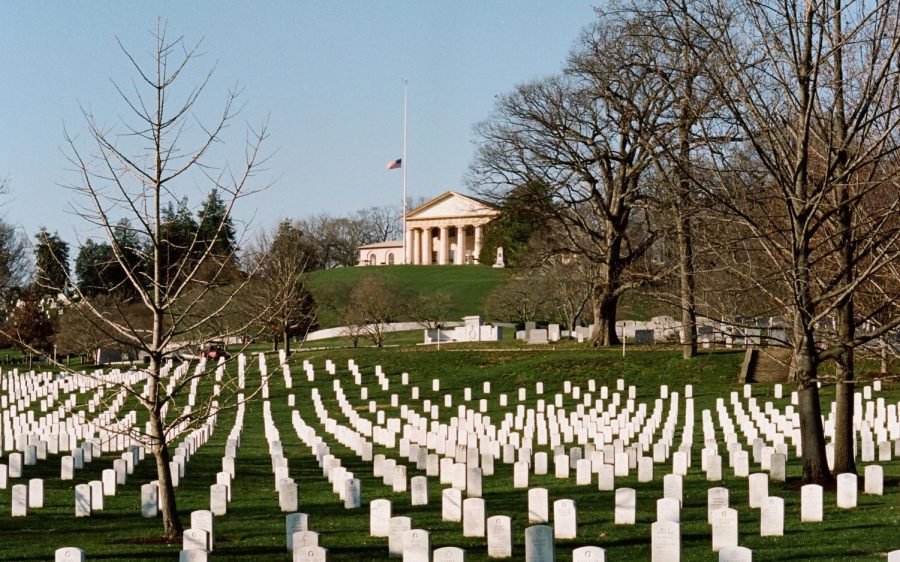Historically Speaking: The mansion above Arlington National Cemetery
The Robert E. Lee mansion, pictured in March 2022, forms a backdrop at Arlington National Cemetery. (Photo by Chad Stembridge via Unsplash)
February 23, 2023
High on a bluff overlooking Arlington National Cemetery is the southern mansion of Confederate Gen. Robert E. Lee. As Union casualties mounted during the Civil War, officials in nearby Washington, D.C., thought it fitting that fallen Federal soldiers be laid to rest on General Lee’s estate. However, the story is a bit more involved.
Today, Arlington is one of two national cemeteries run by the United States Army. Since the Civil War, nearly 400,000 men and women have been buried in its 639 acres. Each day, there are about 30 funerals conducted. All other national cemeteries across the nation are run by the Department of Veterans Affairs.
 Lee’s Arlington estate was said to have been confiscated from the private ownership of Lee’s family following a tax dispute. The estate originally was owned by George Washington Parke Custis, who was the grandson of Martha Washington through her first marriage. When his natural father, John Parke Custis, died, the junior Custis was raised by George and Martha Washington as their own son.
Lee’s Arlington estate was said to have been confiscated from the private ownership of Lee’s family following a tax dispute. The estate originally was owned by George Washington Parke Custis, who was the grandson of Martha Washington through her first marriage. When his natural father, John Parke Custis, died, the junior Custis was raised by George and Martha Washington as their own son.
In 1802, George W.P. Custis began building the “Arlington House” mansion on the estate he inherited. When completed in 1818, he intended the mansion to serve as not only a home but also a memorial to his foster father George Washington.
Custis married Mary Lee Fitzhugh, and their daughter, Mary Anna Randolph Custis, married future Confederate Gen. Robert E. Lee.
Custis’ last will and testament bequeathed a “life inheritance” to Mary Lee, allowing her to live at and run the Arlington estate for the rest of her life but not enabling her to sell any portion of it. Upon Mary Lee’s death, the Arlington estate passed to her eldest son, George Washington Custis Lee.
The trouble began in 1861, when Virginia seceded from the Union and Robert E. Lee resigned from the U.S. Army to become commander of the Army of Northern Virginia.
On May 7, troops of Virginia’s militia occupied the city of Arlington and Arlington House. With Confederate forces occupying Arlington’s high ground, Washington, D.C., was left vulnerable. However, Federal troops soon recaptured the Lee estate.
At the outbreak of the Civil War, most military personnel who died in battle near Washington, D.C., were buried at the United States Soldiers’ Cemetery in Washington, D.C., or Alexandria Cemetery in Alexandria, Virginia. But by late 1863, both were nearly full. Congress passed legislation authorizing the Army to purchase land for military dead.
In May 1864, Union forces suffered large numbers of casualties in the Battle of the Wilderness. The Union army examined eligible sites to establish a large new military cemetery, and within weeks, the Lee Estate was deemed the most suitable. The property was at a higher elevation and free from floods. It had a view of the District of Columbia, and it was the home of the leader of the Confederate States. Denying Lee the use of his home after the war was thought to be a valuable political consideration.
The first military burial at Arlington was for William Henry Christman on May 13, 1864, on a plot close to what is now the northeast gate. However, Arlington did not desegregate its burial practices until President Harry S. Truman issued an Executive Order on July 26, 1948, integrating the armed services.
In 1864, the federal government acquired Arlington at a tax sale for $26,800, equal today at $464,324. Mrs. Lee had not appeared in person but rather had sent an agent to pay the assessed $92.07 in property taxes (equal to $1,595 today). But the government turned away her agent, refusing to accept the tendered payment.
Ten years later, in 1874, Custis Lee, heir to the estate, sued the United States claiming ownership. On Dec. 9, 1882, the Supreme Court ruled 5-4 in Custis Lee’s favor, deciding Arlington had been confiscated without due process. After that decision, Congress returned the estate to Custis Lee, and on March 3, 1883, he sold it back to the government for $150,000 at a signing ceremony with Secretary of War Robert Todd Lincoln (son of Abraham Lincoln). The land then officially became a military reservation.
Beginning in 1863, the federal government housed up to 3,000 freed slaves farming 1,100 acres of the Arlington reserve. The settlement was known as Freedman’s Village. Later, the government asked the villagers to leave. The Army closed the village on the grounds the settlers had been taking trees at night for use as firewood.
Environmentalists had expressed concerns that partial destruction of a historically important stand of native trees was occurring. A historical marker near the woodland notes that, while visiting Arlington House in 1825, the Marquis de Lafayette of France advised Mary Lee Fitzhugh Custis, to: “Cherish these forest trees around your mansion. … It is easier to cut a tree than to make one grow.”
Today, Arlington National Cemetery is one of our national treasures. As long as that mansion stands, Robert E. Lee and the estate’s story won’t be forgotten.
Tom Morrow is a longtime Oceanside-based journalist and author.
Columns represent the views of the individual writer and do not necessarily reflect those of the North Coast Current’s ownership or management.




